1755 The Great Lisbon Earthquake and Tsunami, Portugal
The 1755 Lisbon earthquake, also known as the "Great Lisbon Earthquake" or the "Disaster at Lisbon", occurred in the Kingdom of Portugal on Saturday, 1 November 1755, the Catholic holiday of All Saints' Day, at around 9:40 am. Seismologists today estimate the Lisbon earthquake had a magnitude in the range 8.5-9.0 on the moment magnitude scale, with an epicentre in the Atlantic Ocean about 200 km (120 mi) WSW of Cape St. Vincent.
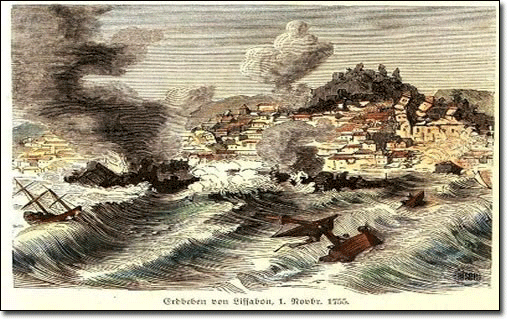
There were three distinct quake shocks over a ten minute period. The first shock was followed by an even more powerful second shock which sent buildings toppling down. According to reports, the tremors and the ground motions from this shock lasted for three-and-one-half minutes. Gigantic fissures of up to 15 feet wide tore through the centre of Lisbon.
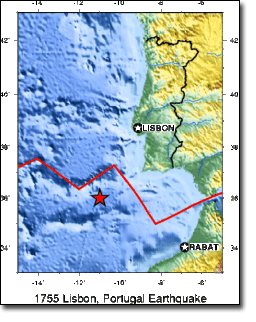
A third shock was less powerful. Effects from the earthquake were far reaching. Severe shaking was felt in North Africa where the quake caused heavy loss of life in towns of Algeria and Morocco - more than 400 miles south of Lisbon. The town of Algiers was completely destroyed. Tangiers suffered great loss of lives and extensive damage.
The earthquake was particularly destructive in Morocco, where approximately 10,000 people lost their lives. Archival records document that the coastal towns of Rabat, Larache, Asilah, and Agadir (named Santa Cruz while under Portuguese rule) suffered much damage. Even the cities of Fez, Meknes and Marrakesh in the interior were similarly damaged. Mosques, synagogues, churches, and many other buildings collapsed in Meknes, where there was heavy loss of life.
In Europe the Lisbon earthquake caused considerable damage in Spain - particularly in Madrid and Seville. Shaking was felt in France, Switzerland, and Northern Italy, too.
However, the worst damage occurred in the south-west of Portugal. Lisbon and its inhabitants were particularly badly hit by the earthquake. In 1755, Lisbon was a great city legendary for its wealth, prosperity and sophistication, it was one of the most beautiful cities in Europe with an estimated population of 275,000.
When the earthquake arrived, most of Lisbon's population were praying in six magnificent cathedrals, including the great Basilica de Sao Vincente de Fora. Within minutes, this great thriving city-port of Lisbon, capital of Portugal and of the vast Portuguese empire and seat of learning in Europe, was reduced to rubble.
The destruction caused by the earthquake was beyond description. Lisbon's great cathedrals, Basilica de Santa Maria, Sao Vincente de Fora, Sao Paulo, Santa Catarina, the Misericordia - all full of worshipers - collapsed, killing thousands. Lisbon's whole quay and the marble-built Cais De Pedra along the Tagus disappeared into the river, burying with it hundreds of people who had sought refuge.
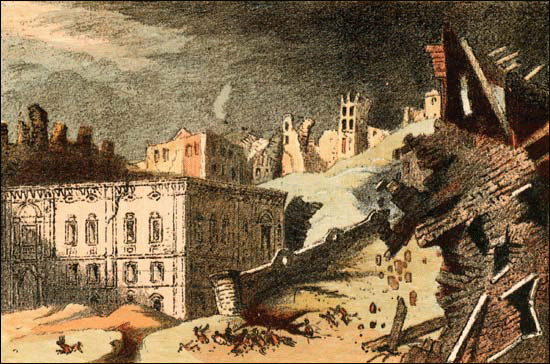
Soon after the earthquake, several fires broke out, mostly started by cooking fires and candles. Some of them were rapidly extinguished, especially in the densely populated areas. But many inhabitants fled from their homes and left fires burning. Narrow streets full of fallen debris prevented access to the fire sites.
Within minutes the fire spread and turned Lisbon into a raging inferno. Unable to run, hundreds of patients in the Hospital Real burned to death. The public squares filled with people and their rescued belongings, but as the fire approached, these squares were abandoned, and the fire reached catastrophic proportions. Two thirds of the city were destroyed by the flames that raged for five days.
Immediately after the earthquake, many townspeople fled to the waterfront, believing the area safe from fires and from falling debris from aftershocks. Some of them looked for safety on the sea by boarding ships moored on the Tagus River.
But about 40 minutes after the quake, an enormous tsunami wave engulfed the harbour and downtown, rushing up the Tagus river, "so fast that several people riding on horseback ... were forced to gallop as fast as possible to the upper grounds for fear of being carried away". The area between Junqueria and Alcantara in the western part of the city was the most heavily damaged by the wave, but further destruction occurred upstream.
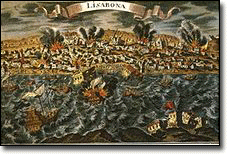
Before the great wall of water hit the harbour, waters retreated, revealing lost cargoes and forgotten shipwrecks. Those people were unaware of the drawback danger and remained around the shoreline to observe the exposed seabed. They did not even know that a tsunami is a succession of waves, rather than just a single one.
Then the first tsunami wave was followed by two more waves which hit the shore, each dragging people and debris out to sea and leaving exposed large stretches of the river bottom. Boats overcrowded with refugees capsized and sank. The maximum height of the waves was estimated at 6 meters.
Lisbon was not the only Portuguese city affected by the catastrophe. The three tsunami waves struck various towns along the west coast of Portugal, in some places up to 30 m high. In the town Cascais, some 30 km west of Lisbon, the waves wrecked several boats. In coastal areas such as Peniche, situated about 80 km north of Lisbon, many people were killed by the tsunami. In Setubal, 30 km south of Lisbon, the water reached the first floor of buildings. Throughout the south of the country, in particular the Algarve, destruction was rampant.
The tsunami destroyed some coastal fortresses in the Algarve and, in the lower levels, it razed several houses. Almost all the coastal towns and villages of the Algarve were heavily damaged, except Faro, which was protected by sandy banks. In Lagos, the waves reached the top of the city walls. For the coastal regions, the destructive effects of the tsunami were more disastrous than those of the earthquake.
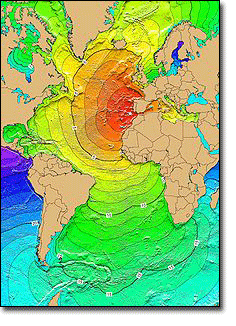
In south-western Spain, the tsunami caused damage to Cadiz and Huelva, and the waves penetrated the Guadalquivir River, reaching Seville. On the coastline of the Madeira Islands the waves still had a height of 15 meters. In Gibraltar, the sea rose suddenly by about two meters. The tsunami waves caused great damage and casualties to the western coast of Morocco, from Tangier, where the waves reached the walled fortifications of the town, to Agadir, where the waters passed over the walls, killing many. In Ceuta the tsunami was strong, but in the Mediterranean Sea, it decreased rapidly.
The tsunami took just over four hours to travel over 1000 miles to Cornwall in the United Kingdom. Galway, on the west coast of Ireland, was also hit, resulting in partial destruction of the "Spanish Arch" section of the city wall. The tsunami crossed the Atlantic Ocean, reaching the Lesser Antilles in the afternoon. Reports from Antigua, Martinique, and Barbados note that the sea first rose by 1.5 m, followed by large waves.
The 1755 Lisbon earthquake was one of the most destructive and deadly earthquakes in history, killing more than a third of the entire population of the Portuguese capital. Tens of thousands of Portuguese who survived the earthquake were killed by the tsunami triggered by the earthquake. The tsunami was accountable for most of the about 70,000 deaths in Portugal, Spain and Morocco.
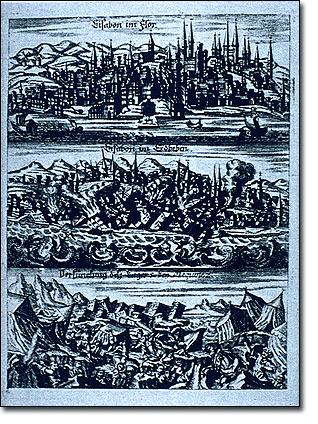
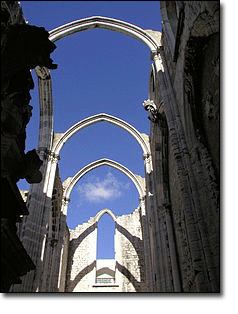
Philosophers of the Enlightenment, notably Voltaire, wrote about the event. Voltaire used the earthquake in "Candide" and in his "Poeme sur le desastre de Lisbonne" ("Poem on the Lisbon disaster"). In "Candide" (1759), Voltaire reported how, "After the earthquake, which had destroyed three-fourths of the city of Lisbon, the sages of that country could think of no means more effectual to preserve the kingdom from utter ruin than to entertain the people with an auto-da-fe (Portuguese for "act of faith", a rite of the Catholic Inquisition in which the sentence was carried out, usually by burning at the stake), it having been decided by the University of Coimbra, that the burning of a few people alive by a slow fire, and with great ceremony, is an infallible preventive of earthquakes."
The philosophical concept of "The Sublime", as described by philosopher Immanuel Kant in the Observations on the Feeling of the Beautiful and Sublime, took inspiration in part from attempts to comprehend the enormity of the Lisbon quake and tsunami.
Eighty-five percent of Lisbon's buildings were destroyed, including famous palaces and libraries, as well as most examples of Portugal's distinctive 16th-century Manueline architecture. Several buildings that had suffered little earthquake damage were destroyed by the subsequent fire. The new Opera House, opened just six months before (named the Phoenix Opera), burned to the ground. Lisbon's magnificent museums, and its magnificent libraries - housing priceless documents and papers dealing with the great history of Portugal's great past - burned to the ground.
Archives and other precious documents were completely destroyed. Works of art, tapestries, books, manuscripts, including the invaluable records of the India Company were destroyed. Also burned was the king's palace, the Royal Ribera Palace, which stood just beside the Tagus River. Inside, the 70,000-volume royal library as well as hundreds of works of art were lost. The royal archives disappeared together with detailed historical records of explorations by Vasco da Gama and other early navigators. Over two hundred fine, priceless paintings, including paintings by Titan, Rubens, and Correggio, were burned in the palace of the Marques de Lourcal.
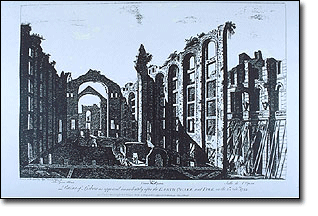
The eyewitness account of the Lisbon earthquake and its aftermath by Rev. Charles Davy, a survivor of this great Lisbon disaster, makes horrifying reading. Only the 1906 San Francisco earthquake is comparable in its economic and psychic impact.
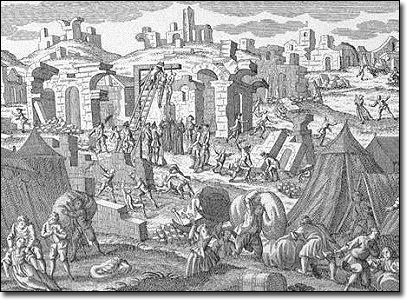
The Lisbon earthquake destroyed a major cultural centre of Europe, dealing a severe blow to the nation of Portugal. Its widespread physical effects aroused a wave of scientific interest and research into earthquakes. The Lisbon earthquake, the first to be studied scientifically for its effects over a large area, can be said to be the slap that led to the birth of modern seismology and earthquake engineering.
The 1755 event is very important also in that it shows beyond doubt that an earthquake which occurs in the eastern Atlantic Ocean can create a tsunami which can cross the Atlantic and move into the shores of eastern North American. This tsunami also went through the islands in the Caribbean, with 21 foot waves being reported. An ocean crossing wave, or wave that travels a long distance from its source, is called a teletsunamic event.
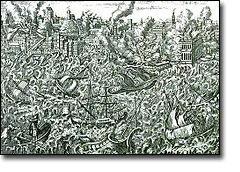
Did you know that...
One of the early warnings of an approaching tsunami comes from nearby animals. Many animals sense danger and flee to higher ground before the water arrives. The Lisbon quake is the first documented case of such a phenomenon in Europe.
Some scientists speculate that animals may have the ability to sense subsonic Rayleigh waves from an earthquake minutes or hours before a tsunami strikes shore. More likely, though, is that the certain large animals (e.g., elephants) heard the sounds of the tsunami as it approached the coast. The elephants' reactions were to go in the direction opposite of the noise, and thus go inland. Humans, on the other hand, head down to the shore to investigate.
For You and Your Loved Ones
With preparedness and safety measures, protect yourself and your family from earthquake risks.
Always good to prepare for an earthquake
Earthquake Warnings are a Game Changer
Stay protected, anytime, anywhere




